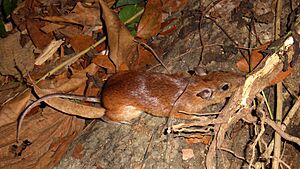Long-tailed spiny rat facts for kids
Quick facts for kids Long-tailed spiny rat |
|
|---|---|
 |
|
| Conservation status | |
| Scientific classification | |
| Genus: |
Proechimys
|
| Species: |
longicaudatus
|
The long-tailed spiny rat (Proechimys longicaudatus) is a type of spiny rat. You can find these rats in countries like Bolivia, Brazil, and Paraguay. They get their name from their long tails and somewhat bristly fur.
Contents
What Does the Long-tailed Spiny Rat Look Like?
The long-tailed spiny rat is a fairly large rat. Its body, from head to tail base, can be between 187 and 250 mm (7.4 and 9.8 in) long. Its tail adds another 121 to 200 mm (4.8 to 7.9 in) to its length.
Unlike some other spiny rats, its fur isn't as bristly. The fur on its back and head is a shiny chestnut color. This color becomes more orange on its sides. Its belly is white, and there's a clear line where the top color meets the white underside. The tail is chestnut brown on top and lighter underneath. Sometimes, you might see a rat missing part of its tail. This is because these rats can drop their tails if a predator attacks them, much like some lizards do!
Where Do Long-tailed Spiny Rats Live?
This spiny rat lives in South America. Its home range stretches from southern Bolivia and northern Paraguay into western and central Brazil.
These rats live on the ground. They prefer dry forests, both those that are untouched (primary) and those that are regrowing (secondary). They also live in areas called cerrado, which are like savannas with scattered trees. You can also find them in places where forests have been cleared, but there are still patches of trees. They usually live in areas below 500 m (1,600 ft) in height, but they have been seen as high as 1,000 m (3,300 ft).
How Do Scientists Study These Rats?
Scientists sometimes study small rodents like the long-tailed spiny rat. They want to understand if these animals carry certain germs that could affect other animals or even people.
For example, a study in Bolivia looked at which small rodents might carry germs that cause certain illnesses. They found that some other types of rats, like Oryzomys nitida and Oryzomys acritus, often carried these germs. However, the long-tailed spiny rat (P. longicaudatus) did not seem to carry these specific germs. This shows that not all animals carry the same kinds of germs.
Conservation Status
The long-tailed spiny rat is a common animal. It can also adapt well to changes in its home. This means it can live even if its habitat is changed a bit by humans.
However, the dry forests where these rats live are sometimes cleared for farming. This means that the number of long-tailed spiny rats might be slowly decreasing. But, because they live in a very wide area and there are still many of them, the International Union for Conservation of Nature (IUCN) has listed their conservation status as "least concern." This means they are not currently in danger of disappearing.


